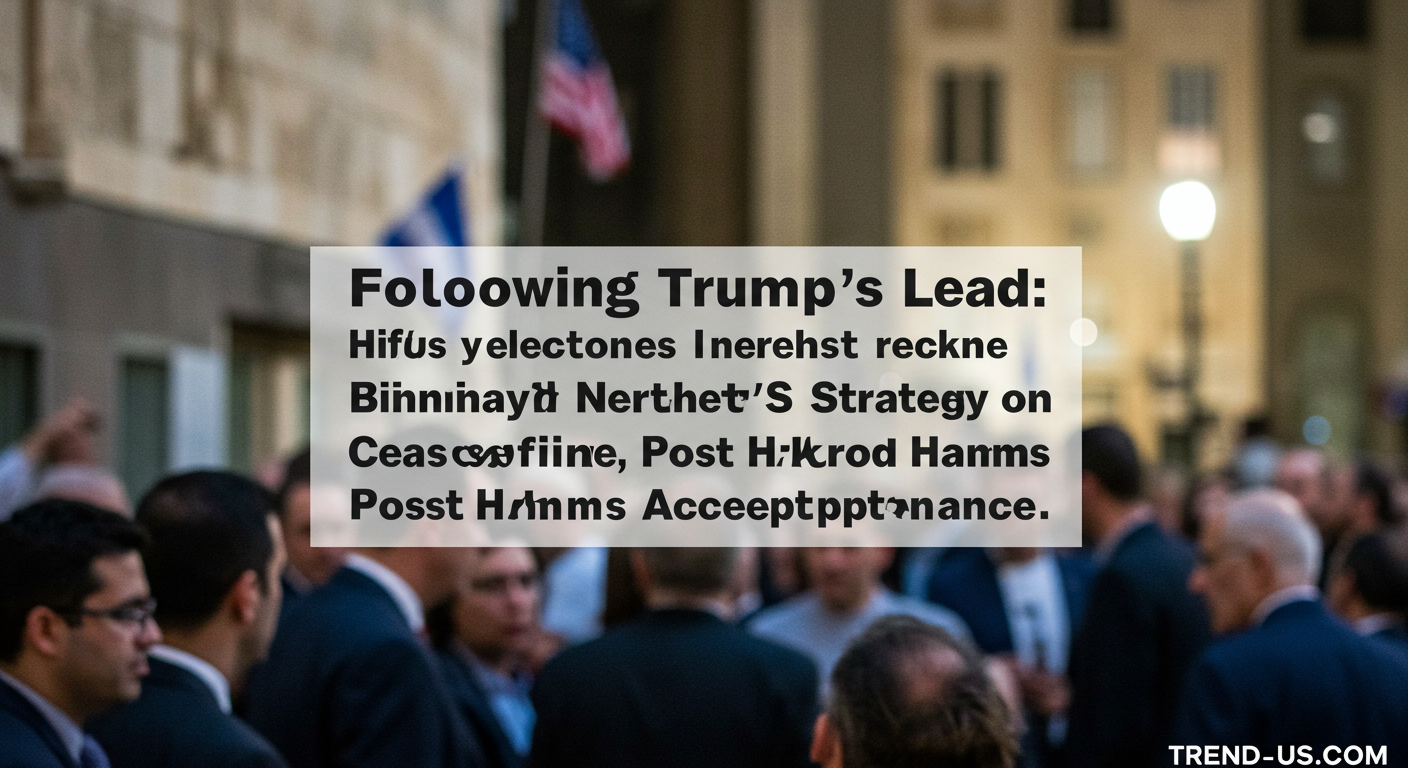Following Trump’s Lead: Netanyahu’s New Strategy on Ceasefire Post-Hamas Acceptance
In recent months, Israeli Prime Minister Benjamin Netanyahu has made headlines with new strategies regarding the Israeli-Palestinian conflict, particularly in regard to ceasefires and negotiations with Hamas. Observers argue that Netanyahu is mirroring certain approaches formerly used by former U.S. President Donald Trump, adapting them to the complexities of Israeli politics and Middle Eastern geopolitics. By examining how Netanyahu’s strategies resemble Trump’s past policies and align with current military and diplomatic realities, we can better understand the evolving dynamics within the region.
### Historical Context of Netanyahu’s Leadership
Netanyahu has been a significant figure in Israeli politics for over a decade. With a track record of fluctuating between hardline stances and tentative peace negotiations, his leadership has been marked by tumultuous relations with Palestinian authorities. His tenure has often seen a steadfast unwillingness to engage fully with Hamas, the Gaza-based militant group that Israel views as a terrorist organization. However, recent developments suggest a strategic pivot in the aftermath of heightened violence and popular pressures within Israeli society.
This transition is not occurring in a vacuum; for years, the Israeli public has witnessed waves of violence, military operations, and rocket attacks. The unpredictability of the situation necessitates that Netanyahu adopts a more pragmatic approach to ceasefires, especially following large-scale confrontations. This willingness for dialogue seems to represent a direct shift in strategy rather than a mere tactical adjustment. By accepting certain realities in negotiating post-conflict situations, Netanyahu is signaling a potential willingness to adopt policies reminiscent of Trump’s “America First” approach, where dealing with groups like Hamas could pave the way for stabilizing the region.
### The Influence of Trump’s Foreign Policy
Donald Trump’s approach to foreign policy was characterized by unconventional tactics, including direct engagement with previously sidelined groups. During his presidency, Trump’s administration facilitated communications with North Korea, potentially allowing for a broader dialogue characterized by boldness and unpredictability. Many analysts believe that Netanyahu recognizes the potential within this framework as he navigates the complex terrain of peace negotiations.
By drawing on some of these tactics, Netanyahu appears to be positioning himself to leverage ceasefire agreements as focal points for further dialogue. Negotiating with Hamas—an organization formally deemed unacceptable for dialogue in previous administrations—aligns with a permissive stance that some of Trump’s strategies embodied. The willingness to acknowledge Hamas’s role as a player in the region indicates a pragmatic approach to conflict resolution rather than a commitment to ideological purity.
### Ceasefire Dynamics in the Post-Conflict Framework
Netanyahu’s current strategy hinges on a nuanced approach to ceasefires, acknowledging them as essential tools for tension de-escalation. These ceasefires not only aim to halt immediate violence but also create a framework for dialogue. By accepting a ceasefire, Netanyahu potentially opens the door to longer-term discussions that could involve economic agreements, humanitarian aid, and infrastructural developments in Gaza—issues that have become critical following the most recent escalation between Israel and Hamas.
The acceptance of ceasefires may also resonate on the international stage. If Netanyahu can successfully formulate agreements that lead towards long-lasting peace, he gains legitimacy both from international peers and the Israeli populace. However, this strategy requires a delicate balance; failure to manage expectations often leads to accusations of appeasement or weakness, which could unite opposition against him.
### Public Opinion and Political Ramifications
Netanyahu’s previous leadership often encountered significant public scrutiny, particularly regarding his hardline military responses. In light of shifting public sentiment—particularly among younger voters craving peace and stability—Netanyahu finds himself compelled to pursue tactical negotiations. Recent surveys indicate an inclination among Israeli citizens towards exploring new avenues in Israeli-Palestinian relations.
By setting a tone focused on pragmatism with its accompanying advantages, Netanyahu is responding dynamically to public pressures that demand change. This shift is particularly evident in urban areas and among the youth, who express discontent with continuous cycles of violence. Should he successfully communicate his strategies as pro-peace initiatives rather than concessions, he may be able to solidify his political standing while reshaping the future of Israeli diplomacy.
### The Role of Regional and Global Actors
In navigating ceasefire agreements, Netanyahu’s strategies cannot be fully assessed without acknowledging regional actors such as Egypt and Qatar. These countries have historically played mediating roles in ceasefire agreements between Hamas and Israel. Netanyahu’s willingness to engage in dialogue with Hamas might signal a tactical alliance with regional powers that also seek stability in Gaza. Munich-style agreements between regional players can additionally create opportunities for economic investments as incentives for peace.
Additionally, engaging with global powers like the United States, which continues to have significant sway in Middle Eastern politics, is crucial for Netanyahu. If his administration can closely align its ceasefire strategies with the broader geopolitical interests of the U.S., particularly concerning stability and combating radicalism, Netanyahu may be able to bolster Israel’s security and international legitimacy.
### Challenges to the New Strategy
Despite the refined approach to ceasefires, various challenges remain inherent in Netanyahu’s new strategy. Opposition from right-wing factions within Israel, who decry any engagement with Hamas, presents a significant hurdle. There’s a delicate interplay between pursuing a dialogue and maintaining support from right-leaning constituents who may view engagement as a betrayal of Israeli security.
Moreover, Hamas’s own internal divisions complicate negotiations. The organization must also contend with differing influences from Iranian-backed factions, which could yield unpredictable outcomes during peace discussions. Any misstep in handling these complex relationships could jeopardize Netanyahu’s strategy, causing a potential backlash both domestically and internationally.
### Long-Term Implications of Netanyahu’s Strategy
As Netanyahu navigates his current strategies toward ceasefire and negotiation with Hamas, the long-term implications will depend on the outcomes of these engagements. Continuous negotiations could herald a new era of Israeli-Palestinian relations characterized by mutual acknowledgment and pragmatic peace efforts. However, failing to maintain a consistent and productive dialogue risks repeating historical cycles of conflict.
Netanyahu’s leadership and its evolution will undoubtedly face scrutiny. The efficacy of his new strategies will hinge on his ability to navigate the unpredictable waters of Middle Eastern politics, balancing domestic expectations with the precariousness of international relations. The ripple effects of these policies could impact not only Israel and Palestine but the broader geopolitical landscape as alliances shift in response to changing leadership tactics on both sides.
In pursuing a path outlined by practical engagement rather than unwavering opposition, Netanyahu has the potential to redefine Israel’s approach to the Palestinian conflict—an ambition shared among many leaders seeking stability in an otherwise fragmented region.



